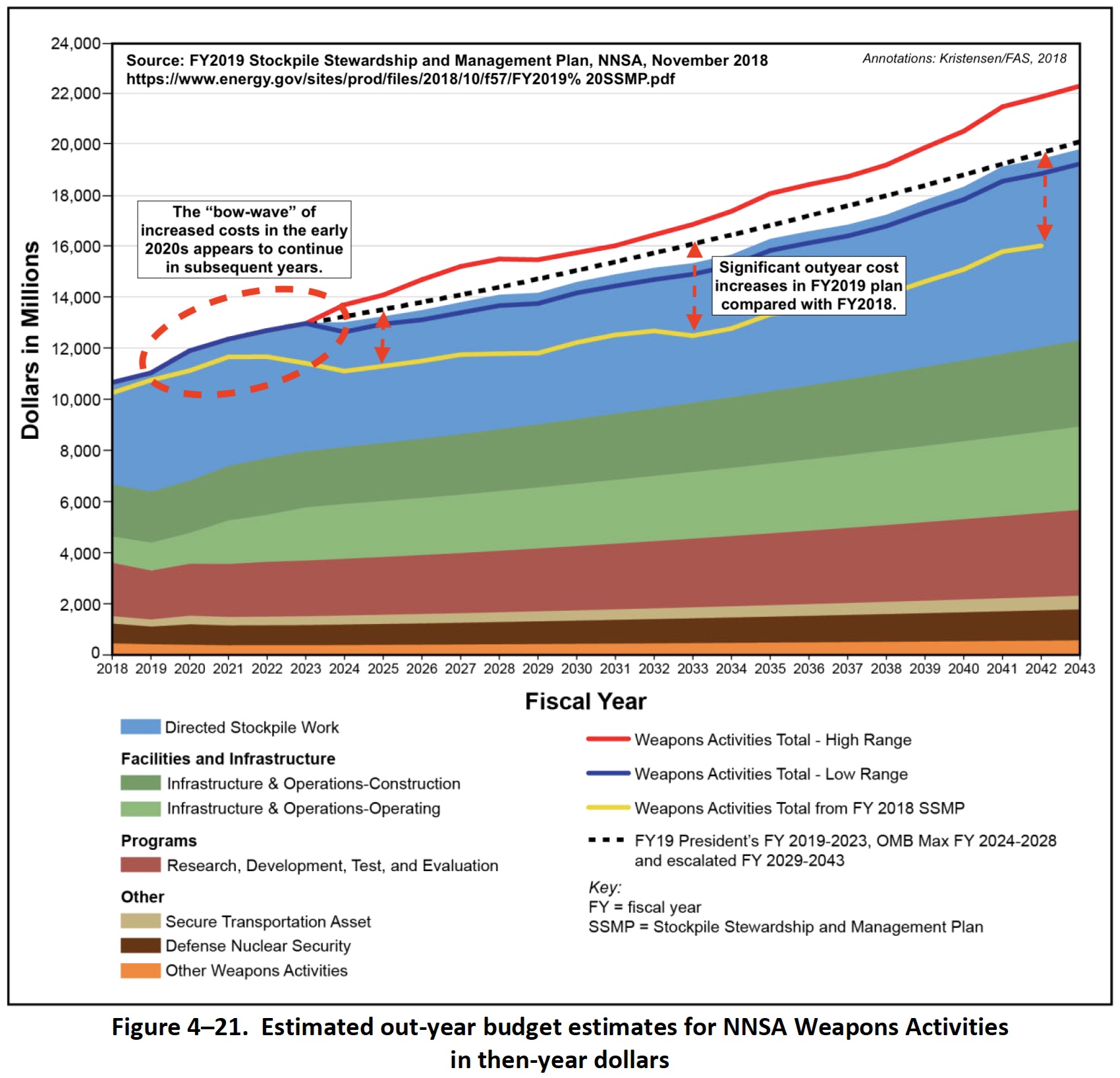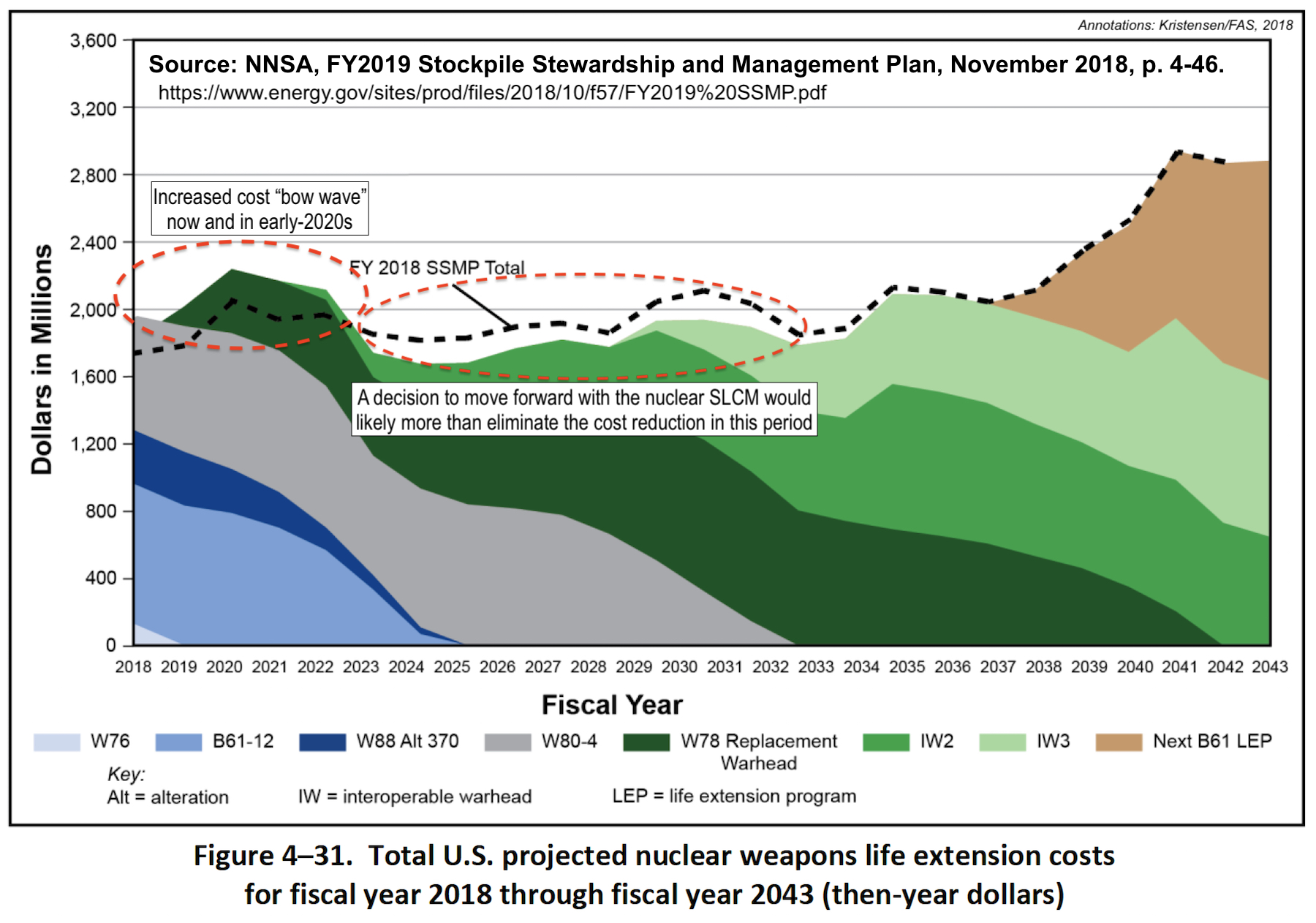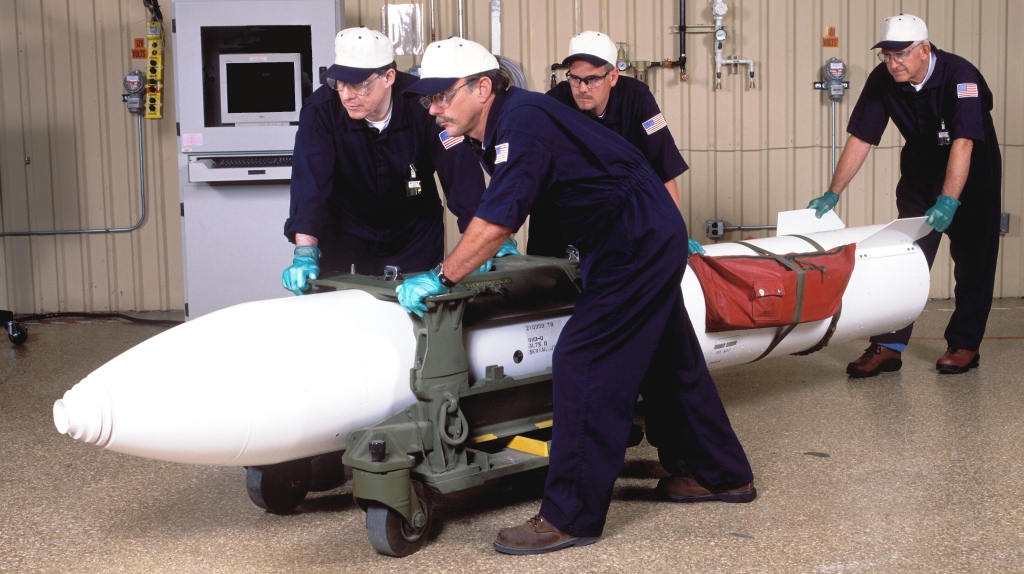NNSA Plan Shows Nuclear Warhead Cost Increases and Expanded Production
By Hans M. Kristensen
NNSA has published the Stockpile Stewardship and Management Plan for Fiscal Year 2019, which updates the agency’s work on producing and maintaining the U.S. stockpile of nuclear warheads.
The latest plan follows the broad outlines of last year’s plan but contains important changes.
The new plan shows significant cost increases and warhead production plans that appear to collide with the fiscal realities facing the Nation in the years ahead.
Significant Cost Increases
The FY2019 SSMP shows significant increases in out-year cost estimates. The “bow wave” of increased costs in the early-2020s that triggered concerns about affordability appears to have become “a flooding” and continue in subsequent years. The cost-drop the previous SSMP projected for the mid-2020s appears not to be happening. Over the next 25 years, NNSA’s spending on nuclear weapons activities is projected to double (see figure below).
Moreover, the addition of a new SLCM not included in the current plan will further increase costs over the next decade-plus.

FY2019 SSMP shows significant cost increases compared with the FY2018 plan. Click on image to view full size
Part of the greater cost comes from increases in the cost estimates for the individual warhead live-extension programs (LEPs). The W78 LEP, one of the two warheads on the Minuteman III ICBM, is now projected to cost $15.4 billion, up 3.3% from $14.9 billion in the previous plan. The high estimate has even greater increase: up from $18.6 billion to $19.5 billion. Moreover, this cost estimate does not include the incremental cost to get to a 30-pit-per-year plutonium capability by FY 2026 to support this LEP. All of the other warhead programs also have cost increases.
In the near-term, these developments result in immediate cost increases and exacerbate the cost “bow wave” in the first half of the 2020s, which shows an increase of several hundred million dollars each year. Total annual LEP costs are lower in the following decade but that reduction would likely be more than erased by expected cost increases and a decision to move forward with development and production of a SLCM as recommended by the Trump administration’s Nuclear Posture Review (see figure below).

Cost growth increases fiscal “bow wave” and new weapons would erase future cost reductions. Click on image to view full size
Extensive Warhead Work Planned
The FY2019 SSMP includes several graphs that expand transparency of the nuclear warhead work now and for the next several decades. Most significantly, the SSMP expands information about sustainment work on legacy warheads (those warheads that are already in the stockpile) by breaking it down by work on limited life components (LLCs) such as neutron generators and gas transfer systems, alterations, surety upgrades, and joint test assemblies (JCSs) used for text flights. Overall, this transparency improves overview of the total workload facing the nuclear enterprise.
Interestingly, the so-called “3+2 warhead strategy” that was highlighted in the previous SSMP and congressional hearings as the only way forward is not mentioned in the new plan at all. The intension was to build three interoperable warheads (IWs) for ICBMs and SLBMs and two warheads for aircraft. IW1, which was previously described as a combination of W78 and W88-1, is now simply referred to as the W78 Replacement Program. The two other IWs – the IW2 combining W87 and W88, and the IW3 involving the W76-1 – are now listed with new names: BM-Y and BM-Z.
The SSMP also shows that six warheads will get a new ISA (Integrated Surety Architecture). This involves “improving DOE/NNSA transportation surety by integrating nuclear weapon shipping configurations with physical security elements.” A “matured integrated surety architecture capability to stockpile systems” matured in FY2018 “for further development and integration activities.”
In the graph below, I have combined the SSMP graphs of warhead LEPs and legacy warhead work into one graph and marked changes and omissions compared with the previous SSMP. The new plan includes two new warheads: the low-yield W76-2 and the SLCM.

FY2019 SSMP warhead work sheets show expanded warhead work but do not include several weapons. Click on image to view full size
The LEP section shows W76-2 work stretching out five years from mid-FY2019 (after completion of the current W76-1 LEP) through much of FY2024 (although work might actually be happening one year earlier). The W76-2 is intended to be deployed on SSBNs along with higher-yield W76-1 and W88 warheads. The W76-2 is intended for use in limited “tactical” scenarios in response to for example Russian use of tactical nuclear weapons. It might also serve a role in the expanded nuclear first-use options against “non-nuclear strategic attack” described in the NPR.
The SLCM is mentioned in the SSMP but with no details about the development and production timeline. NNSA says the SLCM “will be a major new addition in the next decade.” In the combined graph I have included a notional SLCM development and production line for illustrative purposes based on the LRSO timeline. It assumes initial startup in FY2020 after completion of an Analysis of Alternatives (AoA).
The SSMP LEP graph does not include the next B61 life extension program (previously called B61-13 in FY2016 SSMP version), which is scheduled to start in 2038. To correct that oversight, I have included it in the graph. This is a major warhead upgrade with cost estimates in the early-2040s ($1.4 billion in 2043) that go beyond that of any other existing or projected LEP program. And based on the cost graph, annual costs estimates would be even greater after 2043. It is yet unclear why the next B61 LEP will be so expensive.
Altogether, the warhead LEP and legacy graphs show a very ambitious workload for the nuclear weapons complex. At some point in the early-2020s, as many as six different warheads LEPs would be in development or production at the same time, in addition to sustainment of legacy warheads in the stockpile.
The Fate of the B83-1 Megaton Bomb
DOD and NNSA in 2013 decided to retire the B83-1 megaton bomb after the B61-12 enters the stockpile in the early 2020s (prior to this decision the B83-1 inventory had already been significantly reduced). As a result, sustainment work on the bomb was canceled. The previous SSMP included a (poor quality) graph that showed the B83-1 (and B61-11) being phased out. Some B83-1s would be retained in the stockpile “until confidence in the B61-12 stockpile is gained.” But the 2018 NPR appeared to signal a delay of that decision, although the language actually seemed very similar: retain the B83-1 “at least until there is sufficient confidence in the B61-12 gravity bomb that will be available in 2020.”

The FY2019 SSMP shows intension to keep B83-1 megaton bomb until 2028. Click on image to view full size
Yet the FY2019 SSMP shows the intension to retain B83-1 longer, at least through 2028. To do that, the plan revives various sustainment programs, including two, possibly three, warhead alterations. Work is also planned on the gas transfer system and integration of a new “integrated surety architecture.”
Although the NPR and SSMP both indicate the B61-12 is the replacement, they leave some uncertainty by talking about retaining the B83-1 “until a suitable replacement is identified.” The two weapons are used to hold at risk hard irregular and underground targets, and the B61-12 has increased accuracy and appears to have some limited earth-penetration capability. But the language used in the NPR and SSMP about the need to identify a “suitable replacement” could potentially indicate that the B61-12 may not be sufficient and that plans for a new weapon are underway.
Implications
The projected cost increases shown in NNSA’s FY2019 SSMP, and plans to add two new nuclear weapons to the arsenal, are likely to significantly strain the capacity of the U.S. nuclear weapons complex. After initially proclaiming its intension to significantly increase the defense budget in the years ahead, the Trump administration instead has announced a reduction of the FY2020 defense budget.
The growing deficit and declining Federal revenues cause by the administration’s tax cuts are likely to further increase the budget pressure in the years ahead. Combined, these developments are likely to create significant risks for the U.S. nuclear weapons modernization program.
Unfortunately, the NPR glosses over and belittles the cost challenge for the nuclear modernization program. Rather than blindly pushing forward with excessively ambitious programs that would likely force emergency adjustments over the next decade in response to budget pressures, it is essential that the administration and Congress proactively modify the modernization programs now to take into account the significant fiscal risks.
This publication was made possible by a grant from the Carnegie Corporation of New York, the John D. and Catherine T. MacArthur Foundation, the New Land Foundation, and the Ploughshares Fund. The statements made and views expressed are solely the responsibility of the author.
The Federation of American Scientists applauds the United States for declassifying the number of nuclear warheads in its military stockpile and the number of retired and dismantled warheads.
North Korea may have produced enough fissile material to build up to 90 nuclear warheads.
Secretary Austin’s likely certification of the Sentinel program should be open to public interrogation, and Congress must thoroughly examine whether every requirement is met before allowing the program to continue.
Researchers have many questions about the modernization of Pakistan’s nuclear-capable aircraft and associated air-launched cruise missiles.